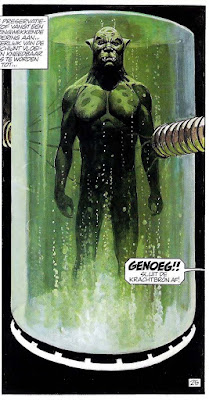This post originally appeared in February of 2011. It will show up in a couple more Weird Adventures
posts after that...
Magical blunderbuss-type firearms were used by some wealthy Dwergen in their early conquest of the Strange New World. The weapons gave these sorcerously inept folk help against the shamans of the Natives and the thaumaturgists of rival Grand Lludd. Today, these antiques sometimes find their way into the
hands of adventurers--in this world, and perhaps
others.
Though they were manufactured in a variety of styles, they’re all muzzle-loading weapons with short, large caliber barrels and flared muzzles. They all can fire relatively normal projectiles of appropriate size (provided there is gun powder) , but their real power lies in specially designed spherical ammunition called “shells.” Interestingly, it appears likely that it was the prior existence of these magical shells which spurred the development of the gun, and not the other way around. No one knows who originally designed the shells, nor for what weapon.
Thaumaturgists (with alchemical aid) can manufacture new shells, but the process is tedious and expensive, so they tend to be rare. Sometimes, a supply is found in Ancient ruins or even other planes. The shells are classified by number, which denotes their effect. All shells of the same number historically tend to be of similar appearance, and modern manufacturers have kept with this tradition. Shells don’t not require gunpowder.
Magic Blunderbuss (Wonderbuss)
Dmg: 1d10 or special;
Rof: 1/2 ;
Range: 50’/100’/300’
Shells: (all spell references per the
SRD)
#1: appears to be a lead ball, but too light for its apparently size. +1 weapon; Dmg. 1d12. These are 80% of all shells found.
#2: brass-appearing. Casts two shadows, one distinct the other shimmering like heat-haze. Leaves a fiery streak when fired. 4d6 fire damage.
#3: appears to be a steel sphere etched with three 7-pointed stars. +2 to hit, 2d8 points of damage. These are 5% of shells found.
#4: glass, containing a roiling green liquid. On a successful strike creates an
Acid Fog as per spell.
#5: glass, faintly glowing and warm like the mantle of a lantern. Acts as the spell
Sunburst, though it misfires on a roll of 1-2 on 1d6, and only does 1d10 damage.
#6: smoked glass. Faint moans can be heard within. Target’s soul is imprisoned on sucessful hit as per
Magic Jar.
#7: silver and etched with glyphs which seem to shift when its not being watched. 1d10, deals double damage to lycanthropes, and extraplanar beings of evil. These are 5% of shells found.
#8: white, with the look of fine china, cool to the touch. Explodes for 5d6 damage in a 20 ft. radius. Sleeping near (2 ft.) of one of these shells has a 75% chance of causing a ringing in the ears (leading to a penalty for rolls to detect things by hearing) lasting 1-4 days after removal of the shell from that distance. Wrapping the shell in cloth will prevent this effect.
#9: appears as a flawless sphere of obsidian. Acts as a
Sphere of Annihilation, though it can’t be moved, and exists only for 1 round before winking out.
Some scholars believe that more shell types are yet to be discovered.






































:no_upscale()/cdn.vox-cdn.com/uploads/chorus_asset/file/3507442/Screen_Shot_2015-03-15_at_10.56.30_PM.0.png)



















